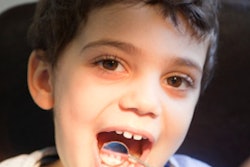
Sealed primary molars were less likely to develop pit-and-fissure caries in a new study, published in the August issue of the Journal of the American Dental Association. Researchers also found sealants delayed the need for restorative work on these teeth.
Previous research has confirmed the benefits of sealants for permanent molars, but fewer studies have looked into their effects on primary teeth. The current study authors, led by Michael Hong, DDS, believe their findings provide much-needed evidence in support of providing sealants for young children.
 Michael Hong, DDS.
Michael Hong, DDS."With findings that firmly correlate dental sealants with caries incidence reduction and delay in time to development of new caries in primary molars, our study supplements the growing body of evidence that sealants should be considered in children at high risk of caries," wrote Dr. Hong, a pediatric dentist at Boston Children's Hospital and a lecturer at the Harvard School of Dental Medicine, and colleagues (JADA, August 2019, Vol. 150:8, pp. 641-648).
When Massachusetts' combined Medicaid and Children's Dental Health Insurance Program ended reimbursements for sealants on primary teeth in 2013, it gave researchers the perfect opportunity to investigate how much sealants prevent decay. Dr. Hong and colleagues looked at sealant and caries experience data from the electronic records of children who visited the Boston Children's Hospital Department of Dentistry before and after the reimbursement change.
They focused their research on children ages 6 and younger with a high caries risk. They only included children with at least two years of follow-up data, and they distinguished between two unique patient cohorts:
- Children who visited the dental operating room or outpatient clinic between April 1, 2009, and September 30, 2013, and received at least one resin-based sealant on a primary molar
- Children who visited the dental operating room or outpatient clinic between October 1, 2013, and November 1, 2016, and did not receive any resin-based sealants
Sealed primary molars were significantly less likely to develop caries, the researchers found. This was true for both patients treated in the operating room and the outpatient clinic.

Children with sealed primary teeth also had a higher percentage of caries-free teeth and a longer length of time until carious lesion development. The sealants placed in the study had about a 5.5% failure rate.
“The delay in caries formation associated with sealant placement on primary molars may defer the need for restorative intervention.”
"The delay in caries formation associated with sealant placement on primary molars may defer the need for restorative intervention until a child has developed the cognition and emotional maturity to tolerate treatment in the dental chair, averting the need for advanced behavior guidance including sedation and general anesthesia," the study authors wrote.
They did include some study limitations, such as selection bias. It also focused on children at one hospital, so the results may not be generalized to practices that do not use the same caries prevention and risk management protocols.
Nevertheless, the researchers hope their findings contribute to the growing body evidence that sealants on primary molars can help prevent decay, delay restorative treatment, and even save insurers money.
"Primary molar sealants could result in cost savings by means of reducing the need for restorative treatment," the authors wrote. "Future directions of this research can expand on the cost-effectiveness of sealants on primary molars, especially as coverage for primary molar sealants continues to be dropped from insurance programs."



















